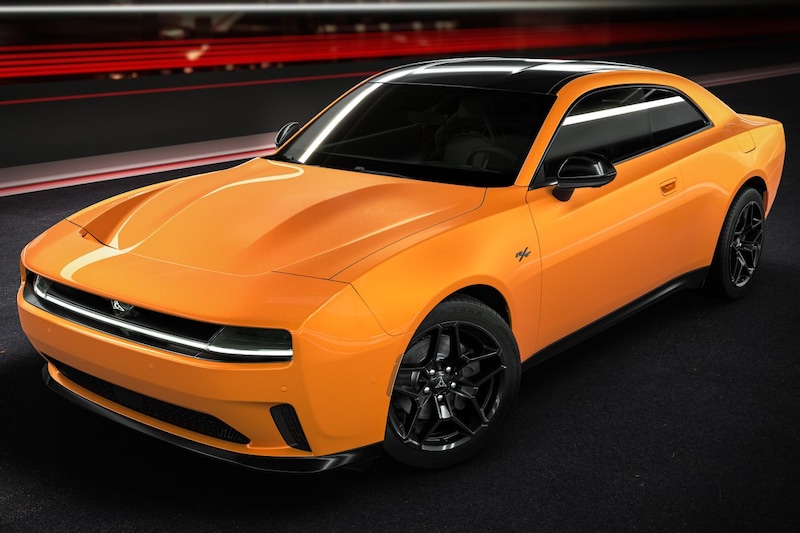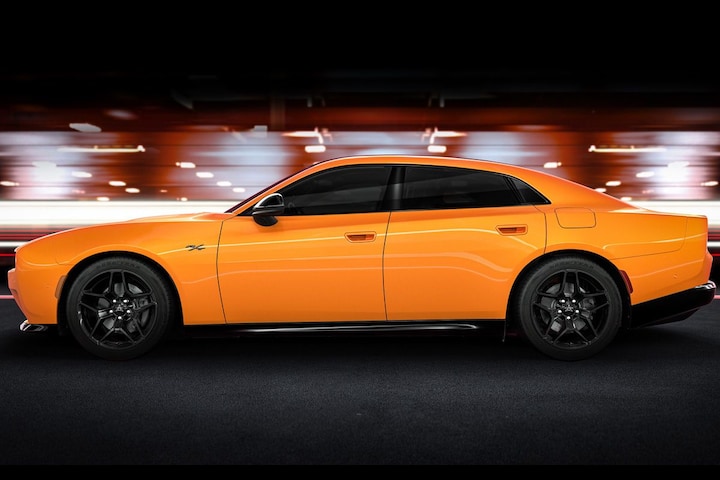Three- or five-door ‘hatchback’, all kinds of powertrains


The Dodge Charger is dead, long live the Dodge Charger! The pure ‘muscle car’ that the Charger was for a long time is being replaced by a much more modern Dodge Charger that is, as promised, fully electric. But not always!
For years, the Dodge Charger and Dodge Challenger have been the last true representatives of a car category that will inevitably disappear: the unadulterated, raw, gas-guzzling, V8-powered muscle car. It has been up in the air for some time that Dodge would eventually replace these cars with EVs. However, the soup is not eaten as hot as it is served, because there will also be ‘normal’ petrol versions of this car again. Parent company Stellantis, just like in Europe, opts for a tactic in which multiple drivetrains are combined on one basis, albeit at a slightly different level than with a Peugeot e-208. The new Dodge Charger is a very significant car for Stellantis as it is the first model on the STLA Large platform.
Up to 670 hp, more later
However, it does start with the electric version. It is distinguished by the historically appropriate name ‘Dodge Charger Daytona’ and is available in two variants: R/T and Scat Pack. The Dodge Charger Daytona has two electric motors that give it four-wheel drive and 550 American horsepower. The Dodge Charger Daytona Scat Pack goes one step further and delivers 670 hp, good for a 0-100 time of 3.3 seconds and a quarter mile in 11.5 seconds. Not enough? Don’t worry: in the future, these 400V versions will be supplemented with an even faster, 800-volt ‘Banshee’ variant, which will definitively relegate Chargers and Challengers of the past to second place in terms of acceleration. There will also be more modest variants. All versions currently have a 100.5 kWh battery pack. The car does not seem to be very economical, just like its predecessors: the R/T can travel 510 kilometers with this package, the Scat Pack 418 kilometers. This is of course according to the stricter North American measuring method. For comparison: a Tesla Model 3 RWD can travel 438 kilometers on paper, while Tesla can promise 513 kilometers in Europe. And then charging, which is not unimportant for a car called ‘Charger’. Dodge promises that the car can charge from 20 to 80 percent in 27 minutes on the fast charger. The brand itself does not mention a maximum charging capacity in press releases, but Car and Driver claims that this is 183 kW.
Fifth door
Did we now mention the Charger and the Challenger? Yes, because the new Dodge Charger replaces both models. The two-door Challenger has been a brutal retro coupe since 2008, while the Charger is a sedan that visually only shares a cool appearance with the Challenger. Now it will simply be one car, but with or without rear doors. Both variants exchange their short sedan hatch for a fifth door, so that you no longer look muddy at Ikea with your muscular Dodge. The interior looks a lot more modern than that of the current Chargers and Challengers, but does not go all the way to digitalization. We see a fairly traditional layout and an apparently quite traditional automatic gear lever, but also a large touchscreen.

The Dodge Charger is now available as a four- and two-door and replaces both the Challenger and the Charger.
On the outside, the new Charger looks exactly like the 2022 Dodge Charger Daytona SRT Concept. Don’t be fooled by that logo and the knowledge that Mitsubishi and Dodge once shared many models: the Japanese brand has obviously nothing to do with this car. This is the new Dodge logo, which will be used again in 2022 for the first time since the 1960s. The logo is placed at the front and back in a rectangular light bar and appears to ‘float’ in an open environment at the front. This is due to the R-Wing, a kind of integrated spoiler in the nose of the electric variant. This allows air to pass through and would therefore contribute to a better streamline, in an EV that does not need the space under the hood anyway. There is also a frunk hiding under that hood, which at 42 liters is still quite a usable size.
Hurricane engines
Petrol versions do not have such an ‘R-Wing’, so in this case count on a traditional grille and a normal, closed hood. Of course we can whistle for a V8, but the new, 3.0, twin-turbo six-cylinder in-line ‘Hurricane’ engines are not for the faint of heart either. The petrol-fired Chargers are called ‘Six-pack’ and here too there are two variants. The Dodge Charger Sixpack SO (Standard Output) produces 420 American horses, the Sixpack HO (High Output) produces 550 hp.
Dodge is taking a big, bold step by marketing these cars as EVs. Presumably, few car-related subcultures are as anti-EV as that of American Muscle Car drivers, and the average Challenger driver would rather become a vegetarian than an EV driver. However, Dodge also has to change, and with those six-cylinders there is at least an ‘escape’.
As a plaster on the wound, the electric versions also make sound, although that fake sound seems very fake. It certainly doesn’t match the sound of the old Hemi. Fortunately, there is the video below for those who want to say goodbye to it quietly.
– Thanks for information from Autoweek.nl


































